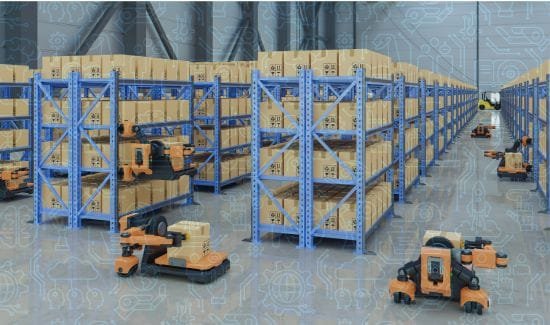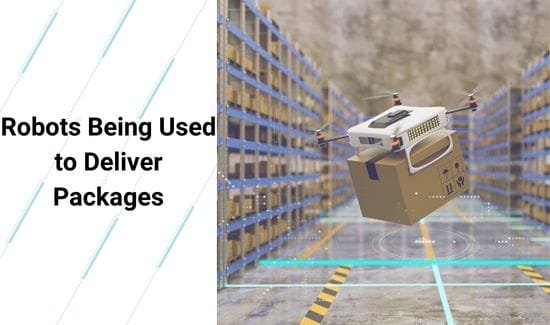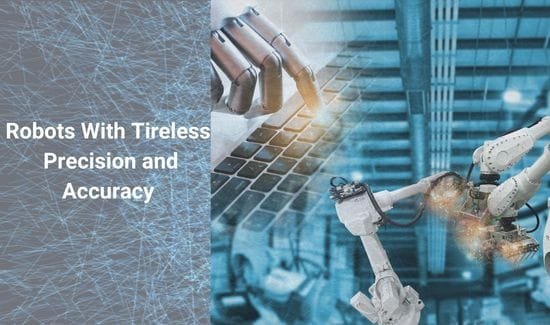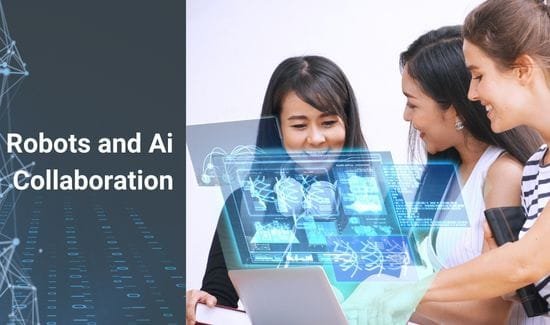
Robots help humans in various ways, from handling repetitive tasks, helping in the kitchen, to handling complex tasks. They are helping humans. Robots in logistics are another type. Assume your fridge is running out of milk! What will you do?
Cab booking to purchase milk from the mall. On the other hand, a friendly food delivery robot with your cold beverage comes to your window. It’s not about delivery, but robots are everywhere and transforming the logistics from online shopping to the corner shop down the street.
What are Logistics Robots?
Robots that manage difficult tasks like picking, transporting, and sorting goods with perfect precision are how logistic robots work. Different industries, such as pharmaceuticals, automotive manufacturers, and e-commerce, seek help from robots in logistics to boost efficiency and accuracy at low expenses, and to perform error-free tasks. Each industry prefers a specific industrial robot to perform a task as required. Industrial robotic integration has made the tasks simple, easy, and efficient. For instance, integration of bots like AGVs, AMRs, and robotic arms into logistics maintains a good workflow while improving scalability and safety.
Today, every business is trying to integrate robotics into their systems for operational benefits, accuracy, precision, and time-saving. Companies use robotics 24/7 for productivity, optimized product management, fast order fulfillment, and reliability.
Modernization in Logistics
Robotics in logistics is all about using pre-programmed machines to streamline the supply chain. Think of them as tireless, comparatively less error-prone worker bees – some resembling giant arms in warehouses, plucking items from towering shelves with pinpoint accuracy. Others take the form of zippy drones, wandering through cityscapes to deliver packages and parcels directly to your doorstep. So, why not take advantage of this technology?
Robotic Impact in Modernization
Indeed, robots undoubtedly provide great benefits like increased efficiency, reduced errors, and much more. Robots have the ability to take work to the next level. Here are some benefits we get from robotics.
Optimized Efficiency
Robots can boost your productivity and have the strength to optimize logistics operations. According to a research study, it has been confirmed that implementing robots in warehouses led to a 20% increase in efficiency. The prediction of experts is that robots must continue to optimize supply chains, making them faster and much more reliable.
Age of Robotics: Upskilling Workspace
As robots become more involved in logistics, there will be a compulsory need for upskilling the workforce. Training programs must equip human workers with the skills needed to work effectively alongside robots, such as robot programming, data analysis, and critical thinking. This will allow them to make informed decisions based on data, update robot performance, and help them troubleshoot any issues. Upskilling encourages an efficient, productive, and creative work environment for better communication between robots and humans. Upskilling in robotics is like an investment with guaranteed success in the future.
Buzz About Robots in Logistics! But Why?
At its initial stages, logistics often faces challenges like high labor costs, human error, and inefficiencies. Bots offer a compelling solution, promising:
Supercharged Speed: Imagine a warehouse significantly reducing fulfillment times for your online orders because of bots, processing thousands of items per hour. No more waiting days for that must-have gadget!
Unwavering Accuracy: Say goodbye to misplaced packages and mix-ups of orders. Robots are programmed for precision, minimizing errors and ensuring your deliveries arrive exactly as ordered.
A Safer Work Interface: Redundant tasks like heavy lifting can be hazardous for human workers. Robots can take on these physically demanding jobs, creating a safer work interface for everyone.
The robotics era is here, and bots will take care of delicate goods and deliver them to their destinations. Logistics’ future is here with humans and bots working together for an effective, efficient, and streamlined supply chain. As you have already seen, we use robots for perfection, accuracy, consistent work with efficiency, managing complex tasks, and more. Did you notice one thing common in all this is accuracy? We use machines, but accuracy is foremost. For accuracy management, industrial settings have a special department for measuring accuracy, precision, and reliability, known as industrial metrology. Industrial metrology is responsible for the accuracy management, precision, and perfection for a better user experience.
Robots Taking Center Stage
The current and of-course, ongoing trend of robots in logistics isn’t an overnight phenomenon. It’s a story of innovation, inspiration, and motivation, starting with the early industrial robots performing repetitive tasks on factory floors. Fast forward to today, we have now much more sophisticated systems that can even pick and pack items themselves, and be able to take flight as delivery drones. Isn’t this obvious that they have come a long way, and the future holds even more exciting possibilities? Let’s explore some of the industries where they are working tirelessly.
1: Robots in Warehouses
Bots work with efficiency that they can identify, grasp, and arrange items accordingly until the fulfillment process. The type of robots we use to perform such tasks is known as AMRs or Autonomous Mobile Robots. However, such bots take care of warehouses automatically and transport goods with delicacy without any special care or hesitation, as they have automated storage and retrieval systems.
Analyzing the Landscape
Warehouse robots streamline various tasks:
- Identifying and picking items using barcode scanners and machine vision.
- Transporting goods and materials between storage areas and packing stations.
- Palletizing finished orders for shipping.
Real-World Impact
1: Bots enhance productivity and optimize picking activity up to 20% or more.
2: Bots work with micro precision and accuracy, which reduces human picking and packing errors.
3: Robots take over physically demanding tasks, minimizing workplace injuries.
2. Delivery Drones

Using bots can be easy or difficult. Let’s see how robots help in minimizing human efforts while keeping accuracy and precision at the top.
Navigating the Landscape
We use delivery drones for many purposes, such as:
- Making last-mile, urban areas, and sensitive deliveries like medicine and food, efficient, reliable, and easy.
- Deliveries to the locations where ground access can be challenging.
- Delivery drones are cost-effective, which motivates people to use them.
Real World Impact
Improvements in delivery speed: Drones have the potential to deliver goods within minutes in urban areas, significantly reducing much more delivery time.-
Improved accessibility: Drones can navigate remote locations or areas with limited infrastructure, potentially improving delivery options for underserved communities.
3. Underwater Logistics
This is another type of robot in logistics. Underwater robotics is usually used for inspecting pipelines, cables, and underwater exploration. Hence, to minimize human life risk, NASA uses robots to inspect underwater, as sending humans can cost their lives, and using robots is an easy and life-saving process. Even if we transport goods to offshore or other aquatic locations, we use AUVs (Autonomous Underwater Vehicles) for fast and convenient supply.
Navigating the Landscape
Applications:
AUVs can be deployed for:
1: Performing maintenance tasks on underwater infrastructure.
2: Delivering supplies or equipment to offshore platforms.
Real-World Impact
AUVs can be helpful in different ways, they can deliver pieces of equipment and handle inspections much faster than traditional methods while ensuring efficiency and accuracy.
Robots can significantly reduce risks like:
- Life losing risks
- Chances of crashing
- Errors in performing specific tasks
- The time commitment for project completion
Overall, it reduces human efforts in a lot of ways.
4: Robots in Automating Roads and Skies

Robots work with nano precision to provide accurate results. Robots help in managing almost every sector, but this is just the tip of the iceberg. Let’s see how robots are automating skies and roads.
Autonomous Drivers: Pre-programmed vehicles that navigate highways without any real-time driver. This is how transporting long-distance goods becomes comfortable, which reduces risks and increases accuracy and efficiency.
Packaging Robots: Packaging robots are taking work to the next level. A study explained that packaging robots work 350 times faster than traditional packaging methods, which drastically increases workflow and overall efficiency.
Navigating the Landscape:
Purpose of Employing Autonomous Driving Trucks.
- Improved efficiency on long-haul routes, reducing driver fatigue and optimizing travel times.
- Potential cost savings for logistics companies through reduced labor costs and optimized fuel consumption.
- Autonomous passenger drones offer:
- A faster and more convenient mode of transportation within urban areas, particularly for short-distance travel.
- Potential for alleviating traffic congestion in crowded cities.
The Rise of Intelligent Automation
Knowledge Infusion: Let’s add a specific example of an object that intelligent sorting robots can handle now, which previously required manual sorting (e.g., “These robots can now handle delicate clothing items like lingerie”). Another example is articulated robots that we usually use in the manufacturing industry. These robots usually come with four to six degrees of freedom to simplify difficult and time-consuming work with advanced methods. This means today robots are serving in almost every field, making tasks much easier and potentially creating opportunities for people to work at ease.
Could intelligent automation eventually eliminate the need for human sorters, or will a human-in-the-loop approach remain crucial? So the answer is No! Bots are here to make complex tasks easy and to aid humans, not to replace them. While bots can do work with proficiency and accuracy, they can never beat a human mind, as a human is more creative and innovative and cannot be replaced.
Collaborative Robotics
The process of robots working alongside humans and minimizing critical work basically, it is called collaborative robotics, which gives a more adaptable workforce, where robots handle routine tasks and humans provide oversight and strategic guidance to work them properly and explore more!
Now, let’s see how collaborative robots can help us, not only collaborative robotics, but we’ll also see AI with these robots. Here we go!
AI in Logistics: Artificial intelligence (AI) is an ever-evolving field to enhance decision-making in logistics. To analyze large amounts of data, AI algorithms can optimize routes, predict demand, and ensure smooth operations.

The Rise of Cobots: Specially designed for side-by-side work, collaborative robots, or “cobots” in short, are smaller yet flexible than traditional robots. This allows them to interact safely with humans in shared workspaces, blurring the lines between human and machine labor.
Collaboration Success
Knowledge Infusion: Include a specific productivity increase achieved by a company that successfully implemented HRC (e.g., “Company X saw a 25% increase in picking efficiency after implementing collaborative robots”). There are many other examples, too, with successful collaborations. But, there are some considerations to ensure they work properly with humans. Here you can see!
Training for Collaborative Workspace
Programmers program a robot as they are programmable machine. People interact with the end result of the program, but if you want to get proper work from robots, you must learn how to deal with the end result properly. Indeed, they are programmable machines, but you must learn their capacities too, like:
- Safety protocols
- Understanding the bot’s capabilities and limitations
- Workflow optimization
- Basic trouble-shooting
Futuristic Approach
Rise of technology also increases the ethical considerations too such as data privacy, algorithmic bias, etc. A powerful framework is integral for careful development and trustworthy use of AI robots. In short, the collaboration of humans and bots promotes great efficiency while maintaining high standards that only human experts can learn and provide.
Conclusion:
AI is here and it’s changing every field from education to heavy-load work. All we can do is just to accept it while moving forward to work creatively, with a different mindset, with an eccentric approach for a better future.
It’s not about logistics, it’s about revolutionizing old traditional ways of working to new, easier, and modern ways for a collaborative more faster, more secure, and innovative future. In this article, we have already explored many industries where bots are working tirelessly without compromising on accuracy while humans focus on creative ideas and innovation. Indeed, the future is here; let’s see what’s next now!



